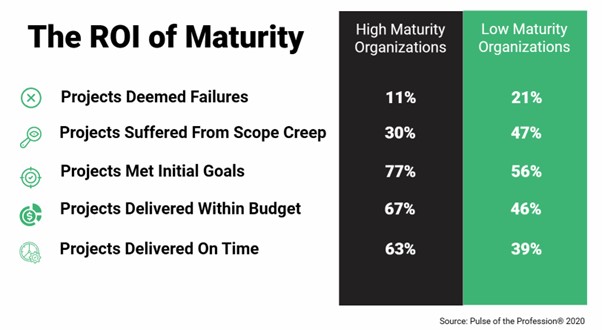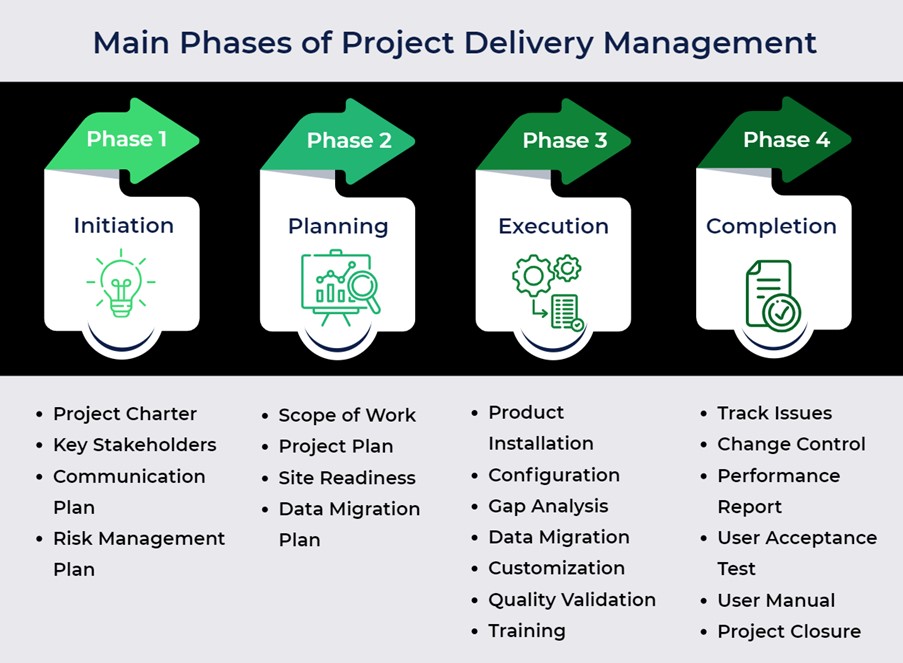
PricewaterhouseCoopers (PwC) unveils a startling fact: 20% of 10,000 projects fail to achieve half their intended goals. Gartner amplifies this concern, noting that 51% of projects fail to meet their targets, while KPMG reports an alarming 50-60% project failure rate. These figures highlight the dire need for a robust project delivery method and set the stage for any project leader aiming for success in today's fast-paced, competitive arena. It transcends the completion of projects within time and budget constraints, demanding that outcomes align with stakeholder expectations and organizational strategies and ultimately deliver tangible value.
But the path to such success is fraught with questions: How does one navigate the complexities of project delivery management, encompassing scope, quality, risk, communication, resources, and change? How can one remain agile despite evolving client and customer needs? And what role do modern technologies and solutions play in elevating project delivery outcomes?
This article delves into these critical inquiries, analyzing the essentials of the project delivery method, its phases, methodologies, and strategic tips. It aims to equip you with a deep understanding of what constitutes an effective project delivery method, its significance, the development process, and how modern AI-driven solutions are redefining the landscape of project execution toward unparalleled success.
What is the Project Delivery Method?
The project delivery method is a crucial aspect of project execution, pivotal in dictating the success or failure of your projects. In a landscape where many organizations still undervalue project execution, consequently losing 11.4% of resources, grasping the essence of an AI-powered project delivery method and its significance is paramount.
As a project leader, you recognize that the project delivery method transcends mere adherence to deadlines; it's about ensuring your projects culminate successfully, within budget, and in harmony with stakeholder expectations, powered by modern analytical solutions.
However, the oversight of this method often culminates in a daunting 50% project failure rate. Alarmingly, 58% of organizations confess a lack of understanding of its worth. This begs the question - how can you sidestep this statistic?
Augmented by AI solutions, the project delivery method stands as your beacon. It embodies the cornerstone of meticulous planning, seamless organization, and impeccable resource management. Through it, you can ensure your project’s timely completion and budget adherence and surpass stakeholder expectations. The era of "gymnastic enterprises" demonstrates that with highly agile and AI-led approaches, achieving a sterling completion rate of 75% on projects with unparalleled quality is within reach.
People Involved in Project Delivery Method
The project delivery method is a collaborative process involving the project owner, who sets goals and objectives, the project manager, who oversees planning, execution, and monitoring, the project team, responsible for task execution across various roles, and the project sponsor, who provides financial backing—all harnessing AI-powered solutions to drive efficiency and successful project delivery in today's competitive landscape.

What Is the Role of a Project Delivery Manager?
A project delivery manager oversees the entire lifecycle of a project, from initiation to closure, ensuring it aligns with its objectives, scope, quality, budget, and timeline. They adeptly manage the project team, stakeholders, risks, issues, changes, and communication, often leveraging AI-powered solutions to enhance efficiency and decision-making. Their roles encompass:
- Defining the project scope, objectives, deliverables, and success criteria,
- Developing and maintaining the project plan, schedule, budget, and resources,
- Leading and motivating the project team and assigning roles and responsibilities,
- Coordinating and collaborating with internal and external stakeholders,
- Monitoring and controlling the project progress, performance, and quality,
- Identifying and managing project risks, issues, changes, and dependencies,
- Communicating project status, updates, issues, and outcomes to relevant parties,
- Ensuring compliance with organizational policies, standards, and best practices,
- Delivering the project outputs and outcomes to the customer or client,
- Closing the project and conducting lessons learned.
The project delivery method, underpinned by AI technologies, is indispensable for success, requiring a blend of technical, managerial, and interpersonal skills to navigate the complexities and challenges of modern project delivery. Adaptability, flexibility, and agility are key, complemented by AI solutions to meet the dynamic demands of today's business environment.
The illustration below highlights the discrepancy between high- and low-maturity organizations based on the information in ‘The Pulse of the Profession 2020’ report. The 2020 version of Pulse incorporates feedback and insights from a diverse group of 3,060 project professionals, 358 senior executives, and 554 directors of project execution offices.
Pulse data show that when it comes to value delivery and optimizing project ROI, organizations that are highly mature in their capabilities outperformed those that are not, across several key project metrics:

What Are the Four Main Phases of the Project Delivery Method?
The project delivery method is a continuous journey through multiple stages, each crucial for efficiently planning, executing, and monitoring projects. Incorporating AI-powered solutions at each phase can significantly streamline these processes:
- Initiation Phase - Define the project's scope, objectives, deliverables, and success criteria. Identify stakeholders and create the project charter, using AI-led insights for precision.
- Planning Phase - Develop a detailed project plan as a roadmap for execution, monitoring, and control. Using AI for risk management, communication, quality, and change management establishes a clear project baseline.
- Execution Phase - Bring the project plan to life, effectively managing the team and stakeholders. Employ AI-powered monitoring to keep the project on track and ensure quality, with real-time communication enhancements.
- Completion Phase - Mark the project's closure by delivering outcomes to the client and gathering lessons learned with AI-led analyses for future project insights.

How to Choose a Project Delivery Method
So, which project delivery method should you use? Project delivery methods are contractual arrangements that define how a project is organized, managed, and delivered. Some of the common methods are:
- Design-Bid-Build (DBB) - A traditional approach where the owner hires a design firm, followed by a construction company post-design.
- Design-Build (DB) - The owner contracts a single firm for design and construction, favored for its streamlined process.
- Construction Management at Risk (CMAR): Similar to DBB but includes a construction management firm during preconstruction, later contracting a construction company.
- Integrated Project Delivery (IPD) - A collaborative approach where a design-build firm is engaged for the entire project lifecycle.
- Build-Operate-Transfer (BOT) - A public-private partnership where a private entity builds, operates, and eventually transfers the project.
Other methodologies like Design-Build-Finance-Operate (DBFO) and Public-Private Partnership (PPP) are also used, each with unique advantages and challenges.
What Project Management Methods Do You Use?
Selecting the appropriate project delivery method is crucial for your project’s success, profoundly influencing its design, construction, and operation phases. The project manager, in collaboration with the project owner, leverages AI-powered analytical solutions to identify the most suitable method, ensuring it aligns with the project’s specific requirements:
- Nature of the Project - Consideration of the project's type and scope.
- Goals and Objectives - Alignment with the desired outcomes and targets.
- Budget - Adherence to the allocated financial resources.
- Timeline - Compliance with the project’s completion schedule.
- Team’s Skills and Experience - Utilize the project team's competencies and expertise.
- Project Risks - Mitigation of potential challenges using AI-led risk management solutions.
With the evaluation complete, the project manager ensures timely delivery within budget and quality standards, applying AI solutions for efficient planning, execution, and delivery.
The project team collaborates on the design, construction, and operation, employing their skills and AI-enhanced solutions to meet project goals.
The project owner ensures that the project fulfills its intended purpose, working closely with the manager and team to achieve its objectives. Integrating advanced project insights and monitoring capabilities can further drive project success, offering real-time analytics and predictive intelligence to navigate complexities seamlessly.
Tips for Project Delivery Method
The project delivery method is essential for guiding projects to successful completion, ensuring punctuality, budget adherence, and alignment with stakeholder expectations. This process involves strategizing, implementing, observing, and regulating all project aspects with the support of AI-powered solutions. Here are some strategies for effective project delivery:
- Define the scope - Draft a detailed scope document outlining the project's objectives, deliverables, and boundaries, using modern analytical solutions to prevent scope creep and manage expectations efficiently.
- Analyze the stakeholders - Utilize AI-led solutions to identify and understand the stakeholders, facilitating more effective management of their involvement and expectations.
- Plan and communicate - Develop a comprehensive project plan detailing timelines, resources, and deliverables. Employ AI-driven solutions to communicate this plan clearly to all stakeholders, ensuring transparency and direction.
- Break down the work - Apply a work breakdown structure (WBS) to segment the project into manageable components. Regularly review the WBS with AI-enhanced solutions to proactively foresee and mitigate potential issues and risks.
- Track actions, issues, and risks - Monitor actions, issues, and risks diligently during project execution with AI-led tracking systems to pre-empt and resolve challenges promptly, ensuring the project remains on course for success.
You can refine your project delivery skills by incorporating these practices and leveraging the right project delivery methods. Advanced solutions automate project execution and offer real-time analytics and predictive intelligence, significantly boosting efficiency and success in meeting objectives and satisfying stakeholder expectations.
Conclusion
The efficacy of a sophisticated project delivery method is paramount in the realm of execution extending beyond mere adherence to schedules and financial constraints. It is fundamentally about aligning projects with stakeholder expectations and delivering substantive value. Mastery in navigating the nuances of project phases, delineating roles effectively, and selecting the optimal methodologies are pivotal for achieving project success. The integration of AI-driven intelligence amplifies the capability of project leaders to make strategic, data-informed decisions, optimize resources, and ensure project outcomes are achieved with precision.
In this context, a solution distinguished by its AI-enabled analytical prowess is a beacon of innovation in project execution. It meticulously harnesses empirical data, encompassing budget, schedule, and quality metrics, while simultaneously enhancing team collaboration. This solution transcends conventional project execution paradigms by automating the documentation and reporting of project deviations and issues. Moreover, its AI-driven predictive analytics serve to refine project delivery methodologies, ensuring efficiency and resource optimization are paramount. This comprehensive approach empowers project leaders to steer their projects with unparalleled foresight and adaptability, setting a new standard for project delivery excellence.
More information about TrueProject on trueprojectinsight.com

About the Author:
Nisha Antony is an accomplished Senior Marketing Communications Specialist at TrueProject, a leader in predictive intelligence. With over 16 years of experience, she has worked as a Senior Analyst at Xchanging, a UK consulting firm, and as an Internal Communications Manager on a major cloud project at TE Connectivity. She is an insightful storyteller who creates engaging content on AI, machine learning, analytics, governance, project management, cloud platforms, workforce optimization, and leadership.
Endnotes
- Nithin Kumar Peratla. “Project delivery method: Types, Phases, Methods, and Tips.” Knowledgehut: September 05, 2023. https://www.knowledgehut.com/blog/project-management/project-delivery-management
- Wellingtone Team. “Wellingtone: The State Of Project Management 2021.” Wellingtone: 2021. https://wellingtone.co.uk/wp-content/uploads/2021/03/The-State-of-PM-2021.pdf
- Plaky Team. “Project management statistics for 2023.” Plaky: 2023. https://plaky.com/learn/project-management/project-management-statistics/
- Ossian Muscad. “A Comprehensive Guide to Project Delivery: How To Turn Over Projects Successfully.” Datamyte: August 24, 2022.
- Project Management Institute Team. “The Pulse of the Profession® 2020 Report. Ahead of the Curve: Forging a Future Focused Culture.” Project Management Institute Team: 2020. https://www.pmi.org/-/media/pmi/documents/public/pdf/learning/thought-leadership/pulse/pmi-pulse-2020-final.pdf?v=2a5fedd3-671a-44e1-9582-c31001b37b61&sc_lang_temp=





